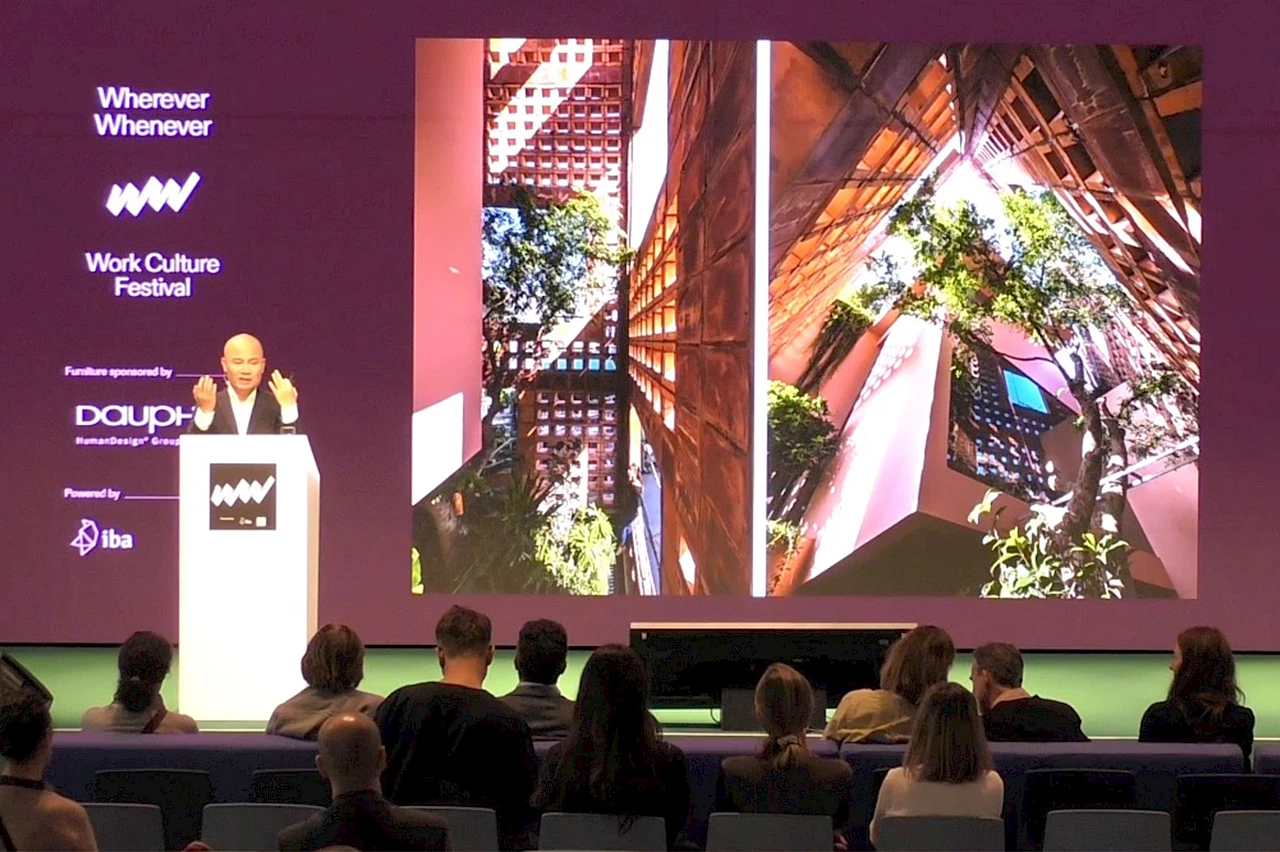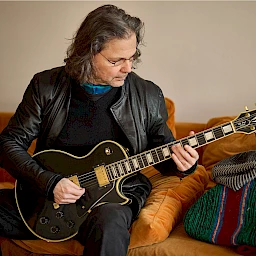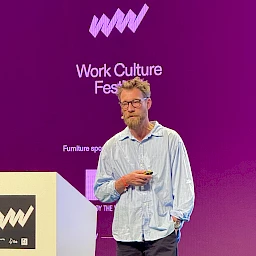At the Work Culture Festival, Vietnamese architect Vo Trong Nghia spoke about the connection between mindfulness, meditation and sustainable architecture. His presentation, Meditation mode: Why architects must heal themselves in order to be able to heal the world made it clear that architectural design must not only satisfy functional or aesthetic requirements, but can also actively contribute to healing the environment and people.
Architecture as a cure for the environment
Vo Trong Nghia initially took a critical look at modern urban expansion and the resulting environmental problems in Asia. The impacts of massive concrete landscapes become especially clear in metropolises such as Ho Chi Minh City, where there is less than one square metre of green space per person. In comparison, cities such as Hong Kong or Singapore with a significantly higher proportion of greenery are examples of more sustainable urban development. This is where Nghia’s projects come in: Through architecture that combines nature and urban structures, he tries to make cities more liveable. As an example, he presented a residential building in the centre of the densely built-up urban area of Ho Chi Minh City, which serves as a miniature park with green roof terraces and vertical gardens. The use of natural elements, especially plants and water, not only serves to enhance the aesthetics, but also to improve the urban climate and air quality.
Sustainability through natural materials and smart design
A central theme in Vo Trong Nghia’s architectural philosophy is the use of sustainable materials such as bamboo and clay. Bamboo is particularly relevant as a building material because it grows back quickly and is therefore an environmentally friendly alternative to concrete and steel. In a restaurant he designed in Vietnam, the entire structure is made of bamboo, which creates a natural cooling effect and drastically reduces energy consumption. Another example of his architecture is a school whose roof is used as an agricultural area. Here, the children not only learn how to grow food through play, but also benefit from an improved microclimate and the natural insulation of the school building.
The link between meditation and architecture
In addition to concepts for sustainable architecture, Vo Trong Nghia spoke at the Work Culture Festival about the importance of meditation and mindfulness in the creative process. He described how he used to suffer from the stress of the modern architecture industry until he found a way to heal himself through meditation. Today, Nghia firmly integrates this practice into his daily routine and also encourages his team to meditate for an hour a day to reduce stress and improve concentration and creativity. He is convinced that a calm mind is essential for sustainable and future-oriented architecture and makes meditation an integral part of his creative work. This practice enables him to design spaces that are not only functional and aesthetic, but also create a deep, harmonious connection between people and their environment.
Meditation architecture: Buildings as places of tranquillity
Vo Trong Nghia also implements his ideas in the form of buildings that are specially designed for meditation and inner contemplation. One example of this is a meditation centre in Myanmar, which uses open structures, natural ventilation and minimalist design to create an environment in which people can find peace and quiet. According to Nghia, there’s a need for physical spaces as places of retreat, especially in times of intense digital networking and constant sensory overload. He sees meditation not only as an individual practice, but also as a social necessity. He therefore calls on architects and urban planners to integrate meditation spaces into urban concepts, for example in office environments or public squares.
Meditation as a tool for the world of work
One particular aspect of his presentation was the relevance of meditation for the modern working world. Nghia argued that meditation not only contributes to an increase in well-being, but can also boost employees’ performance and ability to innovate. Many companies still have a culture of excessive demands and constant pressure to perform. Meditation can serve as a balance here to reduce stress and create more productive and satisfied teams in the long run. His experience shows that just a few minutes of mindfulness practice a day is enough to sharpen awareness and enable more concentrated work. Nghia sees advantages in a conscious mindfulness practice, especially in sectors characterized by tight deadlines and high competitive pressure.
Recommendations for companies
- Spatial adjustments: Companies can create special quiet zones or meditation rooms to offer employees dedicated retreats.
- Integrate meditation into everyday working life: Regular short periods of mindfulness—for example 5 to 10 minutes before or after meetings—can help to increase concentration.
- Managers as role models: If managers and supervisors actively integrate meditation into their daily work routine, their employees are more likely to follow suit.
- Mindfulness training and workshops: This enables companies to make it easier for employees to get started.
- Flexible working models: A flexible working day with short breaks for reflection and relaxation can increase productivity and creativity in the long term.
- tsmodelle: Ein flexibler Arbeitsalltag mit kurzen Pausen zur Reflexion und Entspannung kann die Produktivität und Kreativität langfristig steigern.
Vo Trong Nghia’s approach shows that sustainable architecture is not just a question of materials and energy efficiency, but also encompasses a deeper, holistic dimension and a conscious engagement with the human psyche and work culture. The combination of mindfulness and architecture involved offers a new perspective for the design of liveable cities and workspaces. This approach could play an important role in future urban development and spatial design, especially in times of increasing environmental problems and psychological stress. Nghia has a clear message for the shapers of the future: “Before we can heal the world, we have to heal ourselves.”






